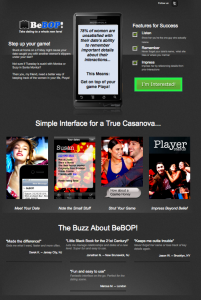The book on digital marketing
I thought about writing a book on digital marketing last year. I got as far as a title “Fishing where the fishes swim – marketing to a digital generation” and a table of contents but never got any further. There’s probably some milage in the idea – I don’t think there’s anything on the market in print that does this, and I definitely think there’s a need (especially in large organisations where marketing has been structured around non-digital thinking). I’ve not got the time to write it. Maybe you will… Or maybe it could be a crowd-sourced effort? The idea’s out there.
Part 1.Introduction
What is digital marketing?
- Setting the scene / overview
- The funnel: AIDA in a digital world
- Introducing the conversion funnel
Part 2. Building for conversion
Customer development
- Understand the audience
- Getting out of the building
- Validating ideas at speed
Lean and agile engineers
- Overview of agile software development
- How to make things happen at speed
Agitating action
- Information architecture
- Persuasion architecture
- Structuring websites to sell
Content is king
- Effective copywriting / writing for conversion
- Micro copy
Landing pages
- Why they are important
- How to build successful landing pages
Mobile
- Responsive design
- Apps
Test test test
- How to measure success
- AB testing
- Multivariate testing
Part 3. Creating a buzz
Viral marketing
- What makes a campaign go viral?
- Ingredients of virality
Infographics
- Why use infographics
- Ingredients of a successful infographic
- Now you’ve designed it, what to do with it
Social engagement
Introduction to social media
- How to decide where to socialise
- Measuring success
- Maintaining a twitter account
- Promoted tweets
- Measuring success
- Maintaining a Facebook account
- Facebook ads
- Measuring success
YouTube
- Creating video that has impact
- Maintaining a YouTube account
- Measuring success
And the rest
VOD?
Part 4. Every journey starts with Google
All about search
- Overview of search, how people search
- Introduce different search engines
How to ascend search rankings (and stay there)
- Introduction to natural search and SEO
- Technical optimisation
- Content optimisation
- Techniques for getting inbound links
- Black hat and white hat
- Measuring success
Paid search
- Introduce AdWords
- Keyword mining
- Creating campaigns
- Writing adword copy
- Managing the account
- Quality score
- Measuring success
Part 5. Building relationships
Email marketing
- Email overview / the virtuous cycle
- Segmentation and campaigns
- Avoiding spam and blacklists
- Measuring success
Loyalty and referrals
- Refer a friend schemes
- Why do people refer
- How to build an effective referral scheme
Part 6. Appearing elsewhere
Affiliate marketing
- Introduce affiliates and networks
- Measuring success
Display
- Advertising on the web
- Advertising on mobile
- Retargeting
Part 7. Making it happen
Convergent marketing
- How to work with traditional marketing channels
- Building the team
- Who do you need?
- Where digital marketing should fit in the organisation
- Closing thoughts and what’s next.









